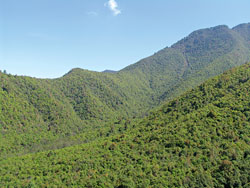|
|
| GREEN PEOPLE POWER: This community forest near Godavari is managed by a user group, and its success could be threatened by both an unrepresentative government and the Maoists. |
But the dissolution of village and district councils by the Sher Bahadur Deuba government in 2002 and the subsequent royal takeover is beginning to undermine Nepal's most celebrated forest conservation success story.
Even so, 800 community forest user groups in Okhaldhunga, Dolakha and Ramechhap, for instance, have invested in 328 school buildings, 107 have paid teachers' salaries, 42 have built bridges and all have established a level of inclusive democracy that governments and INGOs can only dream about. Plus: they have accumulated a bank balance of more than Rs 7 million. Now, powerful and greedy factions are eyeing that money.
"We have seen that when you give authority, power and support to the people, they become vehicles for change," says Bharat K Pokharel, manager of the Nepal Swiss Community Forestry Project (NSCFP) which works with more than 800 community forest user groups in the three districts.
Earlier this month about 30 representatives of forest users groups, political parties, and other civil society activists were brought together in Kathmandu by the Federation of Community Forest Users Nepal (FECOFUN) to strategise.
"We told them: you have a constitution, you have the UN human rights declaration, you have your rights. If people come to take your forest away from you, you must tell them they have no right to," says Ghanashyam Pandey, coordinator of the organisation's new policy advocacy campaign.
FECOFUN represents most of the country's 14,000 users groups, and says it has been pushed to adopt this 'rights-based approach' after security forces began to occupy community forests and the government and Maoists tried to grab their forests and savings. Now, the government is even eyeing the successful community forests that have turned once-barren hills on the rim of Kathmandu Valley for security reasons. "The people living near the forests depend on them for fodder and firewood, for their livelihoods," says Pandey, "but these people sitting in Singha Darbar never think of that."
According to Pokharel, the 1993 Forest Act gives more powers to local forest users groups than even the Local Governance Act provides to VDCs and DDCs. The users groups, which manage more than one million hectares of forests, responded to the act's mandate by helping to check deforestation, particularly in the hills.
Nepal's forest cover, which had shrunk from 43 percent in 1979 to 29 percent in 1998 bounced back after the legislation went into effect. The reason it worked so well was because of local participation in decision-making through inclusive grassroots democracy. An NSCFP study of the three districts where it works found that women make up 33 percent of the groups' membership and Dalits are represented proportionately at both the general membership and committee levels.
To be sure, there were problems with forestry user groups: many were dominated by the high caste village elite, there was less represenation of janjati, Dalits and women but it was changing. After 1 February, there has been a lot more interference in the workings of the groups. By law, they have to renew their agreement with the government to use forest resources for local development. But there are now thousands of user groups that haven't had their agreements renewed. "There is a legal no-man's land," says Jorg Frieden of Swiss Development Cooperation (SDC).
In addition, foresty user groups have always had to face harassment from the Maoists. Usually, it is to include Maoists in committees, restricting choices in the use of resources, even changing the official name of user groups to revolutionary ones. But lately, the Maoists have been extorting money from the user group's kitty so money meant for repairing bridges or paying teachers is going to the upkeep of guerrillas. The Maoists have analysed community forestry from a purely class standpoint, and don't see the rural empowerment and environment protection that it promotes. Baburam Bhattarai in a magazine interview in February even said: "While it may seem that the community forest users committees are autonomous units, they definitely have a class structure. Village biggies enjoy greater facilities than the voiceless." But citing the Maoist ratification of the Basic Operating Guidelines, Bhattarai added: "Our present policy is to permit all national and foreign projects which are not pawns of the monarchist reactionary government and are involved in genuine service of the community to work without hesitation."
However, it may be the very democratic bent and growing resources that have made the user groups a target for both sides in the conflict. The Maoists tax the groups and the government is trying to control them. "Those who believe in democracy support the community forestry process but the present government doesn't believe in it," says FECOFUN Secretary General, Bhola Bhattarai.
The government denies this, saying it is only trying to allow district officials to 'coordinate' local activities. "We don't want to take power from FECOFUN," says Damodar Parajuli, joint secretary at the Ministry of Forests. "A few people in FECOFUN are trying to grab resources at the cost of other poor people in the districts."
But other experts are convinced the government is eyeing the user groups' savings. "The government has always wanted to control the funds," says Santosh Mani Nepal of WWF Nepal. Because the government is dragging its feet in setting up community forestry in areas of the tarai, villagers have started 'capturing' them. In 2004, FECOFUN studied 178 such groups. On average they had captured 215 hectares each and had generated savings of Rs 75,000.
But such success is a double-edged sword because savings of the user groups from the sale of forest products make them vulnerable to Maoist extortion, which in turn invites government backlash against the very groups that are protecting forests.



